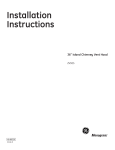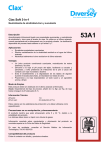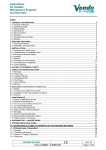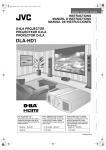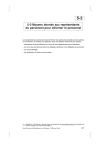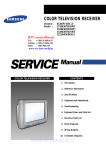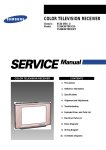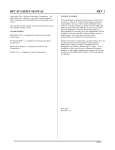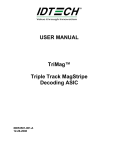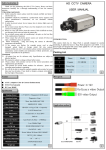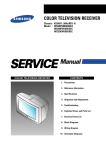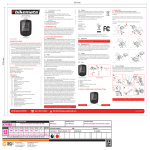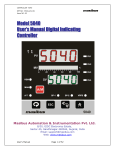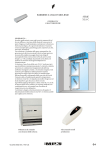Download DC Linkert Series Notes & Pictures
Transcript
1 DRAFT OSKRG Research/Restoration Bulletin #2 52-71 Linkert/Tillotson Carburetors This research and restoration bulletin was created with input and assistance from members of the OSKRG. The report consolidates the best available information at the time of creation and may be updated or revised at a future date. If errors are identified, or there is additional information on the subject of this report that has not been included, please send corrections or additions to: [email protected] & [email protected] © 2014 By OSKRG 2 Forward As the opening statement on page 1 states “This research and restoration bulletin was created with input and assistance from members of the OSKRG. The report consolidates the best available information at the time of creation and may be updated or revised at a future date. “This work is by no means definitive. A realistic expectation of this work would be that there are going to be errors but at least it is a place to start the conversation from. Consider this bulletin to be a living thesis, as empirical evidence presents itself this document will be modified to more accurately reflect what was original equipment on the Ks & Sportsters from 1952 through 1971. It addresses the M53 Linkert series, the DC Linkerts and the Tillotsons. There are a number of models and years that remain an outright mystery like what production bike was the M53A Linkert carb used on if any at all to areas that might be considered “gray” like what models and years was the DC-1L used on and when did Harley stop using the DC-10 and start using the DC-12. If you have a bike that you are confident has its original carb on it we would love to hear from you. Within the document we have a “score card” of sorts to track what carb people have on their original bikes, this score card can serve as an important validation tool. Hopefully over time we can mold this document into a valuable tool to help enthusiast in their restoration efforts. © 2014 By OSKRG 3 Table of Contents Forward Page 2 Section 1, 52-56 Linkert Carburetors: Page 3: Carburetor Model, Carburetor Part Number, Jet Diameter/Number & Year What Is Actually On Your Bike-Please Let Us Know Page 4: Linkert 53 Series Notes & Pictures Section 2, 57-65 DC Linkert Carburetors: Page 5: DC Linkert Carburetor Model, Bike Type, Model Year & Comments Page 6: DC Linkert Carburetor Model, DC Linkert Carburetor Part Number, Jet Diameter/Number & Comments Page 7: What Is Actually On Your Bike-Please Let Us Know Pages 8 & 9: DC Linkert Series Notes & Pictures Section 3, 66-71Tillotson Carburetors: Page 10: Tillotson Carburetor Model, Tillotson Carburetor Part Number, Jet Diameter/Number & Comments Page 11: What Is Actually On Your Bike-Please Let Us Know Page 12: Tillotson Series Notes & Pictures © 2014 By OSKRG 4 Section 1 52-56 K Model Linkert Carburetors Green Indicates Some Degree of Confidence Carb was Original Equipment Yellow Indicates Some Uncertainty R10 Linkert Carburetor Model Part Number Jet # & Dia. 1952 1953 M53 27146-52 #8 ( ) or #9 (.067) K K & KK 1954 1955 1956 Comments: The bombsight venturi on the M-53 is 1 ¼” so it won’t fit the later 53-A1 carb but it will fit on an earlier 1 ¼’ body. Both carbs still use the flathead style bowl though, which is different from the Panhead version as the float lever and needle and seat housing is offset and not “in line” as on the OHV carbs. In other words the bowl gasket on sidevalve carbs are an “O” and the bowl gasket on OHV carbs has two “O”s, one big, one small. (Scott.L.) M53-A KH & KHK Comments: M53A exists, application unknown, perhaps a transitional model between the M53 and M53A1. M53-A1 27146-52A #8 ( ) or #9 (.067) KH & KHK KH & KHK KH & KHK Comments: The M-53A1 carb has a full size venturi just like the Linkert M-74B used on panheads, 1 ½” standard open venturi and no bombsight. Both carbs still use the flathead style bowl though, which is different from the Panhead version as the float lever and needle and seat housing is offset and not “in line” as on the OHV carbs. In other words the bowl gasket on sidevalve carbs are an “O” and the bowl gasket on OHV carbs has two “O”s, one big, one small. (Scott.L.) © 2014 By OSKRG 5 52-56 Linkert Carburetors Linkert Carburetor Significant Part Number Changes from Parts Book to Parts Book vs.1 Note: A column Part Number Color Change Indicates a Part Number Change. Text in Red Indicates What the part is Supposed to Fit has Changed. Parts Book Year Carburetor Complete Part Number Linkert Carburetor Model 1953 PB 1954 PB 1956 PB 27146-52 27146-52A 27146-52A M-53 M-53A1 M-53A1 What Is Actually On Your Bike-Please Let Us Know 1952 Linkert Model M53 M53-A M53-A1 OTHER © 2014 By OSKRG K 1953 K 1954 KK KH 1955 KHK KH 1956 KHK KH KHK 6 Linkert 53 Series Notes & Pictures M53 Carburetor M53A Carburetor Air intake, M-53A on left, M-53A1 on right. You can see the one piece choke lever assembly © 2014 By OSKRG M53A1 Carburetor Air intake, M-53. Note two piece choke lever. Lever part very hard to find. 7 Linkert 53 Series Notes & Pictures Manifold end, M-53. Note offset fuel intake on all M-53 models. Manifold end, M-53A. Manifold end, M-53A1. These are obviously unrestored carburetors. The high and low speed adjustment needle controls should be cad plated, also the bowl nut, throttle control components. M-53A1 with some of original black paint remaining. Manifold end, M-53A1. © 2014 By OSKRG 8 Top down view, M-53A1. This was complete take-off unit, including air cleaner and intake manifold in background. Note manifold is parkerized finish, manifold nuts are cad plated. M-53A1, air cleaner assembly side. Scott L. Additional comments about the Linkert finishes: “I would confirm Roger’s observation re: black paint. Bruce Palmer’s book confirms this on the Panhead models, including the M-74B. They are not hard to paint. I put on a crappy bowl, then set the ends on the sticky side of contact paper, then use an exacto knife to trace around the outline of the end openings, and then spray away. Interesting thing I have been reading as I have been researching all finishes for the Linkerts. The finishes used (zinc dichromate, silver cad, and even the black paint) all seem to break down fairly quickly at temperatures above 120 degrees. Sitting between the cylinders of an air cooled motorcycle puts temps well above that threshold and would explain why the finishes are almost always evenly worn off on used Linkerts.” © 2014 By OSKRG 9 Section 2 57-65 DC Linkert Carburetors Green Indicates Some Degree of Confidence Carb was Original Equipment Yellow Indicates Some Uncertainty R10 Linkert Carburetor Model 1957 XL 1958 XL XLH 1959 XLCH XL XLH 1960 XLCH XLH XLCH 1961 XLH XLCH 1962 XLH XLCH 1963 XLH XLCH 1964 XLH XLCH 1965 XLH XLCH DC-1 Open Vent Comments: 27155-57. Open Vent. The early versions (pre-1960 or so) don’t have the patent numbers on the bowl. Later versions have a patent number. 1 year only choke lever for 57. Theorizing HD used same part number for all DC-1 models. 1957 version of DC-1 used washer 6187 in throttle lever assembly, replaced in 1958 by 6182. DC-1 Closed Vent Comments: 27155-57A. Closed Vent, XL-XLH. 1959 parts book indicate the female thread float valve assembly (27382-57) was changed to the male hose barb float valve assembly (2738257A) in mid-1958. Change from open vent (27343-57) to closed vent (27343-57A), and main jet (27317-57 - #9 @ .067) to (27317-57A - #4 @ .0625) occurred at or around the same time. DC-1L Comments: Believed to have been used on all 1958 high compression models, though not positively confirmed. The DC-1L is the same carburetor as the reconfigured DC-1 used in mid-late 1958. DC-10 Comments: 27155-57A. Same carburetor as the reconfigured DC-1 except model stamp. All models. Control wire block screw 1058W replaced 1063 in 1961; throttle lever stop screw 1073W replaced with 1074W in 1961. 1963 Service Manual suggests DC-10 still in use through 1962, though many original 1961 bikes are observed to have DC-12 carburetors. DC-12 Comments: 27155-57B. Improved float valve assembly (27382-61). Second opening added to needle housing, needle tip cut off leaving only enough bevel to seat when closed. Control wire block screw 1058W replaced 1063 in 1961; throttle lever stop screw 1073W replaced with 1074W in 1961. 1963 Service Manual suggests DC-10 still in use through 1962, though many original 1961 bikes are observed to have DC-12 carburetors. Early versions of DC-12 had flat surface @ inlet hose barb, later versions had recessed surface @ inlet hose barb. Late versions of DC-12 have brass “anti-sprattle” plate to reduce spillage through overflow vent. Used on 1964 XLA. DC-6 Comments: 27155-57B. Observed on several original 1965 models. Believed to be replacement version of DC Linkert series, introduced around 1965 and installed interchangeably with DC12 on late 1965 models. Believed to have brass “anti-sprattle” plate. 1957 1958 1959 1960 1961 1962 1963 1964 1965 1966 DC-2 Comments: Service cars DC-1M Comments: XLA. The DC-1M is the military version. It is powered down as the military spec for the XLA was a 750CC motorcycle. Same as 27155-57 with #1 main jet @ .052. Shovelhead DC-7 Comments: 1966 Shovelhead. Same as 27155-57B, with #45 main jet @ .070. DC-11 XLR Comments: Multiple DC Linkerts stamped DC-11 observed with same float valve assembly used on K model Linkerts (27382-52) with 3/8 UNF male threaded inlet to accept 3/8” 90 degree hose inlet elbow used on competition models. Competition manuals suggest the DC-11 was a carburetor option for the XLR. DC-3, DC-4, DC-5, DC-8, & DC-9. Comments: No documentation of these models. custom applications. © 2014 By OSKRG Some Linkerts stamped with these numbers believed to be blank bodies stamped by someone other than Linkert or Harley-Davidson for 10 57-65 DC Linkert Carburetors- Contradicting Opinions Green Indicates Some Degree of Confidence Carb was Original Equipment Yellow Indicates Some Uncertainty-Red Indicates Other Sources Assertions Linkert Carburetor Model 1957 XL 1958 XL XLH 1959 XLCH XL XLH 1960 XLCH XLH XLCH 1961 XLH XLCH 1962 XLH XLCH 1963 XLH XLCH 1964 XLH XLCH 1965 XLH XLCH DC-1 Open Vent DC-1 Closed Vent DC-1 Other Source Rational for our assertions: Based primarily on a number of original paint unmolested bikes. DC-1L DC-1L Other Source Rational for our assertions: Based primarily on a number of original paint unmolested bikes. DC-1M DC-1M Other Source XLA 1960 XL Rational for our assertions: Shop dope bulletin clearly states the DC-1M was for the 1957 XLA. XL only produced in 57, 58 & 59 per “Legend Begins” book. DC-10 DC-10 Other Source Rational for our assertions: Based on a number of original paint unmolested bikes & extensive research of service manuals and parts books. DC-12 DC-12 Other Source Rational for our assertions: We have tracked the parts books very carefully – we have detailed the configurations of fixed jets and needle and seat assemblies and pinned down the dates of changes. The earlier service manuals do not show the DC-6 and DC-12 models, indicating they were later versions. DC-6 DC-6 Other Source Rational for our assertions: We have tracked the parts books very carefully – we have detailed the configurations of fixed jets and needle and seat assemblies and pinned down the dates of changes. The earlier service manuals do not show the DC-6 and DC-12 models, indicating they were later versions. 1957 1958 DC-2 DC-1M 1959 Service Cars Non XL, XLH & XLCH Models 1960 1961 1962 1963 1964 1965 1966 XLA Shovelhead DC-7 DC-11 Comments: XLR Multiple DC Linkerts stamped DC-11 observed with same float valve assembly used on K model Linkerts (27382-52) with 3/8 UNF male threaded inlet to accept 3/8” 90 degree hose inlet elbow used on competition models. Competition manuals suggest the DC-11 was a carburetor option for the XLR. DC-3, DC-4, DC-5, DC-8, & DC-9. Comments: No documentation of these models. © 2014 By OSKRG 11 57-66 DC Linkert Carburetors Part Numbers, Sizes & Thicknesses Yellow Indicates Some Uncertainty Linkert Carburetor Model DC-1 Open Vent Part Number 27155-57 Jet # & Dia. #9 .067 Throttle Disc 9A Comments: Open Vent. The early versions (pre-1960 or so) don’t have the patent numbers on the bowl. same part number for all DC-1 models DC-1 Closed Vent Throttle Body Thickness @ Bolt Holes to Manifold .219” Throttle Body Opening Diameter 1.375” Later versions have a patent number. 1 year only choke lever for 57. Theorizing HD used #9 .067 9A .219” 1.375” #4 .0625 9A 1.375” #4 .0625 9A 1.375” #4 .0625 9A .281” 1.375” 27155-57B #4 .0625 9A .281” 1.375” Part Number Unknown #20 .0452 12 .219” 1.0625” Comments: Closed Vent , XL-XLH DC-1L Comments: XLCH DC-10 27155-57A Comments: XLCH DC-12 Comments: XLH-XLCH, 64XLA DC-6 Comments: DC-2 Comments: Service cars DC-1M Comments: DC-7 #1 .052 XLA. The DC-1M is the military version. It is powered down as the military spec for the XLA was a 750CC motorcycle. Part Number Unknown #45 9A .281” .070 Verified -66PN for #45 Jet 1.375” Comments: Early Shovelheads 1966 DC-11 Comments: DC-3, DC-4, DC-5, DC-8, & DC-9 Comments: No documentation of these models. Some Linkerts stamped with these numbers believed to be blank bodies stamped by someone other than Linkert or Harley-Davidson for custom applications. © 2014 By OSKRG 12 57-65 DC Linkert Carburetors DC Linkert Carburetor Significant Part Number Changes from Parts Book to Parts Book Vs.3 Note: The pictures in some cases do depict the part accurately, in others they don’t. The intent of their inclusion is more for reference. Parts Book Year Comments/Changes 57 PB 58 Year 59 PB 60 Year 61 Sup. 62 Sup. 27433-57 Carb Support Bracket 57-59 XL & XLH. 27433-58 Carb Support Bracket 58-59 C & CH New parts for 61*Carburetor: • Control wire block screw • Throttle control bracket screw • Support nut • Throttle control bolt clamp Same as 61 Comments in addition carburetor throttle lever stop screw & spring PN 27270-49 replaced by 27270-49A 63 PB 65 PB © 2014 By OSKRG Carburetor Complete Part Number Possible DC Linkert Carburetor Model Carburetor Matched Float Valve & Seat Carburetor Jet Carburetor Nozzle Vent Housing Assemble Tube-Idle Bleed Throttle Disc High Speed Needle Valve 27155-57 DC-1 DC-1L DC-1M 27382-57 27317-57 27343-57 Not Present 27280-57 27297-57 27331-57 27324-57 27339-57 27155-57A DC-10 27382-57A 27317-57A 27343-57A 27280-57 27297-57 27331-57 27324-57 27339-57 DC-6 & DC-12 27382-61 27280-57 27297-57 27331-57 27324-57 27339-57 27280-57 27280-57 27297-57 27297-57 27331-57 27331-57 27324-57 27324-57 27339-57 27339-57 27155-57A 27155-57B 27155-57B 27382-61 27317-57A 27155-57B 27155-57B 27382-61 27382-61 27317-57A 27317-57A 27343-57A 27343-57A Carburetor Main Nozzle Idle Tube Assemble Low Speed Needle Parts Never Changed 27322-58 27322-58 13 57-65 DC Linkert Carburetors What Is Actually On Your Bike-Please Let Us Know 1957 1958 DC Linkert Model XL XL DC-1 Open Vent-90’ Gas Inlet 1 2 XLH 1959 XLCH XL XLH 1960 XLCH XLH 1961 XLCH XLH 1962 XLCH XLH 1963 XLCH XLH XLCH 1964 1965 XLH XLCH XLH XLCH 1 2 & 1 XLA 1 1 DC-1 Open VentStraight Gas Inlet DC-1 Closed Vent 1 DC-1L DC-10 1 DC-12 DC-7 DC-2 DC-4 DC-11 DC-Other © 2014 By OSKRG 3 1 1 1 DC-6 DC-1M 1 1 1-XLA 1 1 2 14 DC Linkert Series Notes & Pictures Early & Late Float Bowls, Common Carb Bodies, Open & Closed Vent & Anti-Splash Plate © 2014 By OSKRG 15 DC Linkert Series Notes & Pictures 5 Needle & Seat/Fuel Inlet Combinations © 2014 By OSKRG 16 DC Linkert Series Notes & Pictures Documented -57A & -61 Needle & Seat/Fuel Inlet Combinations © 2014 By OSKRG 17 DC Linkert Series Notes & Pictures Different Thickness Throttle Bodies 2 Different Throttle body Thicknesses with the Same Part Number. The One on the Left is about 1/16” Thinner. © 2014 By OSKRG 18 DC Linkert Series Notes & Pictures XLCH Gas Tank Fuel Strainer & Outlet & Carburetor Fuel Inlet Fittings Help with this topic, here are comments you made on the subject Scott & pictures you sent. . The 1958 XLCH used the DC-1L, with mid to late bikes having the dual nylon hose barb fitting, one coming out of the female float valve inlet fitting and the other coming out of the fuel tank strainer. By 1959, all models came with the DC-10, with the -57A float valve assembly and straight hose barb inlet. All 1960 models also had the same DC-10 configuration. In 1961 the -61 float valve assembly was introduced, designated DC-12. This is the dual notch, chopped needle tip version of the needle and seat with straight hose barb inlet. We determined the DC-11 was a racing version for the XLR. It has a male threaded float valve assembly inlet and appears to be the same assembly as used on K model carburetors. The 90 degree, 3/8” inlet elbow from the -54R strainer and hose kit fits onto the threaded float valve inlet and connects to a 3/8” inside diameter fuel line. © 2014 By OSKRG 19 I also dug through all my -54 strainers and lo and behold I found a used one with the metal hose barb, 62378-52, still installed. When I talked to Bill Morris today he said he will check his 1971 XLCH to see what is coming out of the fuel tank strainer. If the fitting there is nylon, I will defer to Roger on 62374-58. If it is metal, I will instead continue to think the nylon version of the strainer outlet valve had a very limited application to 1958 and very early 1959 only. When I spoke with Bill today he confirmed he knew 100% of the history of the 1961. He has had offers up to $30K, but won’t sell it specifically because, as he put it “that bike has been a part of his life for over 50 years.” Whatever is on the fuel tank strainer on that bike is what the factory put there when they built it. I am intrigued by the plastic/nylon gas fitting. I am going to assume it is nylon rather than plastic as plastics from the time didn’t have the same properties as modern fuel resistant properties. I have never seen a strainer with the nylon fitting installed nor have I come across a needle and seat assembly with the nylon barb seated in the female threaded inlet. I see your point though about the parts book. I also looked at the -63 parts book which indicates 62374-58 replaced the 90 degree elbow in late 1958 to 1961. I also looked at the oil tank group and see that item 63578-52 appears to be the part number on the smaller 5/16” fittings that I have routinely seen in the strainers I have come across. The use of 63578-52 seems logical given that it is the identical fitting to 63533-41 in the racing strainer kit, only smaller to fit the smaller stock size fuel line. In my parts book analysis I noted that it appears that around 1959 the needle and seat assembly was changed from the early female version to the male hose inlet version. We must assume this was done on the XLCH as well as the other models, which would mean only one 62374-58 would be needed for the strainer outlet rather than two. Yet, the 1963 parts books still call for two from late 1958 through 1961. The parts book simply can’t be right here. Once again, I’m skeptical that we can rely completely on the parts book to reach conclusions on this. That said, there is a period from mid 1958 to perhaps early 1959 when the early female inlet needle and seat was used without the 90 degree elbow where a nylon fitting may have been used. My guess is that if that is the case it the nylon fittings were not used on many bikes. Note the 1959 parts book was issued on September 1, 1958 around the time the new 1959 models were rolled out. The -57A needle and seat assembly was specified for all Sportster models. It is hard to see a window other than mid 1958 to rollout of 1959 where the nylon fitting would have been used with the -57 version of the assembly. Makes me wonder – is your 1959 a really early one possibly produced before September 1, 1958? If so, maybe you have a pretty rare bike where a transitional part was used. I have an early 1965 XLCH with the early version of the horn mount bracket. I have looked high and low for another of these horn mounting brackets and have never seen one anywhere. Perhaps you have a similar anomaly? I found a needle and seat assembly in my parts pile that was in the old brown envelope with the early black ink logo and parts markings. I looked inside and noted that the early -57A needle and seat assembly came with the hose, which had the same inside diameter but had a much smaller outside diameter than the later version of the hose which appears to have been introduced in 1959. The XL and XLH models may have had the thicker hose from ’57 through ’59 because the clamp 9998 fits that hose but is too big for the smaller diameter XLCH hose used in 1958. Intuitively, it seems the smaller version of the hose would connect well with the nylon barb fitting in the photo you sent. That said, the rarity of the nylon barb, along with the fact that nylon was in its infancy at the time, causes me to be a bit cautious. A parallel in time is the use of the ESNA (Elastic Stretch Nut of America) or nylock fasteners. Until 1957, Harley had been using the metal tension nuts then changed over to the wine colored ESNA nuts in 1957 (the invention was patented by ESNA and the wine color was proprietary and protected by patent. That is why early nylock fasteners are incorrect on restorations of the period and why knowledgeable restorers will use RIT dye to recolor clear fasteners to look like an early ESNA product.) In any event, it makes sense Harley may have used a nylon fuel fitting in 1958 and 1959 and even up to 1961, but I still find it very hard to understand why there are none out there today. It seems there should be some left in NOS inventory. I am going to call Bill Morris later today to see if he has come across any of these, whether they are on his all original 1961 XLCH, and whether he has any in inventory. Of course I will let you know what I find out. Not sure if you noted in the photos I sent there was one shot of the 90 degree racing inlet fitted to the early female needle and set and right next to it was an unexplained needle and seat assembly where the inlet barb was soldered into a female threaded fitting. This might have been a precursor to the later style needle and seat assemblies introduced around 1959. I still have no explanation for that version of the needle and seat. © 2014 By OSKRG 20 Like the DC-1L we will figure this one out. Having you point out alternatives to the conventional wisdom is exactly what is needed to reach a reliable conclusion for would-be restorers. I will let you know what I find out from Bill Morris. Scott © 2014 By OSKRG 21 DC Linkert Series Notes & Pictures Early DC-1 Pictures Early Open Vent DC-1, 57 to Early 58 9A Throttle Disc used on all Stock DC 1, 1L, 12, 6 & 7 Carbs © 2014 By OSKRG DC-1 with Early Bowl with No Patent Numbers & 57 Only 90 Degree Fuel Inlet First Version Needle & Fuel Inlet used On the DC-1 Carb, Pointed needle & Single Notch Inlet with 90’ Gas Inlet 22 DC Linkert Series Notes & Pictures Later DC-1 Pictures #9 Main Jet 9A Throttle Disc Closed Vent, Early to Later 58 No Patent Numbers © 2014 By OSKRG “Unmilled, Single Notch” Gas Inlet, Later 58? 23 DC Linkert Series Notes & Pictures DC-1L Pictures More Needed © 2014 By OSKRG 24 DC Linkert Series Notes & Pictures DC-1M Pictures Needed © 2014 By OSKRG 25 DC Linkert Series Notes & Pictures DC-2 Pictures DC-2 Pictures, Service car applications, Float Bowl on Opposite Side © 2014 By OSKRG 26 DC Linkert Series Notes & Pictures DC-6 Pictures DC-6 Needle & Seat, “Milled” Inlet End with Dual Notch & Blunt Needle “Milled” Area DC-6 With Anti-Sprattle Plate: Definitely in the DC-6 and DC-7 versions but not all DC-12s. Probable came in around 1965 – perhaps something Linkert added to try to save the business but too little too late and Harley never acknowledged it in their parts books? Someone Wrote: ”that baffle helps DC-6 With #4 Jet © 2014 By OSKRG arrest a rare annoying Linkert trait. If you’re moving at high speed and you grab all the binders you can in order to set up for a tight corner, the fuel sloshes to the front of the bowl opposite of the bowl vent tube. As you stand the bike back up and peg the throttle wide open the fuel now sloshes over to the opposite end of float chamber where it enters the top of the vent tube and exits the carb spraying the rider. You will smell it. In extreme cases if you’re hanging off the right side of bike you can get a face full of hi-test. 27 DC Linkert Series Notes & Pictures DC-7 Pictures Milled End-Dual Notch Fuel Inlet with Blunt Needle #45 Main Jet with AntiSplash Plate © 2014 By OSKRG 28 DC Linkert Series Notes & Pictures DC-10 Pictures Needed © 2014 By OSKRG 29 DC Linkert Series Notes & Pictures DC-11 Pictures More Needed Help with this topic-Comments from Scott on the subject I took a close look at the K model needle and seat assembly and noted it had two fuel flow notches and a pointed needle. It fit perfectly into the DC Linkert bowl. I’m sure this is what was on the DC-11 carburetors when I disassembled them. The 90 degree 3/8” racing inlet elbow also fit perfectly onto the bottom of the assembly. That said, I’m reasonably certain the DC-11 was different from other DC models because it came with the K model needle and seat (27382-52) and its protruding male (fine) threaded inlet. This would resolve the apparent conflict you noted from the 1959 competition parts catalog and would seem to confirm the Linkert DC – 11 was a racing configuration. I will note, however, that if the racing assemblies used 3/8” fittings and hoses, you would think the needle and valve assembly would have a bigger inside diameter. Not that the smaller diameter would cause a bottleneck – the bigger hose diameter would be designed to reduce hose friction in the gravity feed from the tank and by the time the fuel got to the bowl it would fill it up pretty fast, especially if the truncated needle was substituted. That point aside, Roger I hope you agree conclusion on the DC – 11 is consistent with what you noted in the competition parts catalog. © 2014 By OSKRG 30 DC Linkert Series Notes & Pictures DC-12 Pictures Needed © 2014 By OSKRG 31 DC Linkert Series Notes & Pictures DC Linkert Racing Carburetor Modifications on a DC-12 Modifications on DC-12 Much Larger Fuel Inlet Webco Spacer Block for More Fuel Capacity Very Large Unnumbered Main Jet & Pinched Off Vent Tube Very Large Need & Seat Un-bored Venturi from a DC-12, Observe the Ridge Clear Hose Venting top Of Webco Spacer from Top to Bottom, Purpose Unclear © 2014 By OSKRG Bored Venturi from the DC-12, Observe Absence of Ridge & Less Metal on Inner Edge of Hole. 32 DC Linkert Series Notes & Pictures DC Linkert Racing Carburetor Modifications on a DC-12 Enlarged Throttle Body Opening Standard Throttle Body Opening for the DC 1, 10, 12, 6 & 7 © 2014 By OSKRG 33 DC Linkert Series Notes & Pictures © 2014 By OSKRG 34 DC Linkert Series Notes & Pictures © 2014 By OSKRG 35 DC Linkert Series Notes & Pictures © 2014 By OSKRG 36 Some Tips on Finding & Restoring Old DC Linkert Carbs by Scott Lange. Finding Old DC Linkerts: There is still a good supply of these carburetors floating around at swap meets, though prices are increasing and you really have to pay attention when you are buying one. There are 14 different threaded openings in the pot metal DC Linkert, any of which can be a pain if you have to install a helicoil. The two most important to pay attention to – and the most often bad on used carbs for sale at swap meets – are the high speed needle valve housing opening and the carburetor bowl nut opening. Look close at these two openings, jiggling the needle valve housing and carburetor bowl nut to see if they are firmly seated. Also, check for signs of JB weld or locktite that have been used to make up for stripped threads. Take a pass on those units where either of those two openings are messed up. In general, the more pieces on the carburetor for the model you are looking at, the more likely it is a complete original carburetor. When you see a mix of early and late parts, you never know what is inside. Take a close look at the body and bowl surfaces. If they are scraped down, banged up, dented or corroded away, keep in mind these defects generally can’t be fixed. When you get done restoring the carburetor, each imperfection will stand out vividly. Try to find bodies and bowls that have as smooth and unblemished finishes as possible. You will be much happier with the result when done restoring. There are early and late bowls. The early ones don’t have the patent number, the later ones do. (We should sort out the break point in the Linkert bulletin). The bowl is visible so if you plan to have your bike judged it is a good idea to find the right bowl. As you might expect, nice early bowls are harder to find than the more plentiful later ones. The bodies and bowls are the key components of the DC Linkert. Everything else is available without much difficulty, but nobody is (nor will) making replacements. When the originals run out, there won’t be replacements available. Having collected a huge pile of DC Linkert parts, I can tell you the number of carburetors I can put together is limited completely by the available bodies and bowls. These aren’t cheap anymore, so when you find good ones at a decent price you can never have too many. Tearing Them Down When You Have Found One: Breaking down a DC Linkert is pretty easy with one or two notable exceptions. They adventure starts when removing the carburetor bowl nut. The carburetor bowl nut gets a lot more torque than it should, as attaching to the carburetor support bracket often involves torqueing the bottom nut too much. The extra torque makes the carburetor bowl nut torque down further into the carburetor body, pulling the relatively soft threads on the body outward. More on that in a second. First, you have to remove the tiny little brass idle tube that runs up through the center of the carburetor. Hopefully, the base of the idle tube is not stuck in the carb bowl nut and you can see the head of the tube just sticking out of the carburetor when the bowl nut is removed. DO NOT GRAB THE BOTTOM OF THE TUBE AND PULL DOWN. The tube is actually two pieces – a tiny brass tube and a “head” that affixes to the tube via a tiny pointed tip that fits into the idle tube opening. If you pull down to remove the idle tube, you may disconnect the “head”. This doesn’t hurt if the head comes off cleanly without breaking the tiny pointed tip in the process. Unfortunately, the tiny pointed tip breaks off half the time you pull it from the idle tube. Instead, using the thumb of your right hand, and middle finger of you left hand, stick your digits into each end of the venturi and use them to “spin” the idle tube to free it up from the tight fit into the hole at the top of the venturi. If it is frozen in there, try spinning and rocking it back and forth slightly to unstick if from the body. Once the tube starts to move, try spinning again, holding tightly and © 2014 By OSKRG 37 applying downward pressure. You will see from the position of the head when it is starting to move. If you can work it loose with just your fingers, insert a needle nosed pliers into the venturi and tigten gently around the idle tube. Rotate the pliers back and forth gently until the tube breaks loose from the body. Apply downward pressure to work it out. The pliers may rough up the tube slightly, but this can be fixed later. With the idle tube out, now you are looking down into the number one challenge on these carburetors – the nozzle. It shares the same threads as the carburetor bowl nut. To get the nozzle out for restoring the body, it has to travel all the way out of the threaded opening. Even if everything is in perfect shape, you will encounter resistance when you hit the threads distorted by the bowl nut. Generally, though, things aren’t in perfect shape. Look down the threaded opening to check the condition of the brass nozzle inside. If the slots are clean and straight and there is no damage to the threaded opening, you bought a nice carburetor. You still aren’t out of the woods yet thought. The first thing NOT to do is use a screwdriver blade that is too wide. To remove the nozzle properly, you need a fairly wide screwdriver blade that bridges the center hole of the nozzle. Generally when a screwdriver has this wide of blade, however, it also has a couple of even wider “shoulders” even further up. If you try unscrewing the nozzle with a screwdriver with wide shoulders, you will end up mashing the pot metal threads of the body. This will effectively preclude restoration of the carburetor because you won’t be able to get the nozzle out after that. What you must do is grind off the wide shoulders on your screwdriver blade so they won’t tear into the body threads while you try to extricate the nozzle. Extrication of the nozzle is the biggest challenge to restoring a DC Linkert. I’ve ruined more bodies on this exercise than any other way, by far. If the carburetor has been sitting around, the brass nozzle is going to be stuck hard in the threaded opening, gunked in by dried gas residue. There will have been some unequal metal heat expansion and also dissimilar metal galvanic action happening there, so the nozzle is going to be set in there tight and it will take some brute force to break it loose. NEVER USE BRUTE FORCE! If you try to power the nozzle out, the screwdriver will mushroom the slots on the nozzle out and they will then begin to dig into the soft pot metal threads. The more force you apply, the greater the distortion, and before the nozzle has traveled 1/8” it will be frozen in there with brass shards and mangled pot metal threads. When you get to the nozzle part, get a propane torch and some penetrating lubricant like WD40 or Kroil. Shoot a little down the opening to begin to seep down into the nozzle threads. Set the body gently into the bench vise, vent opening pointed straight up, then apply some heat to the body surrounding the nozzle. 15 to 20 seconds on each side of the body is all you need. After heating, put a little more penetrant into the hole. While everything is still warm, insert your modified screwdriver blade and carefully begin to unscrew. Be very careful as you back the nozzle out to keep the screwdriver blade centered in the hole and not chewing on the body threads on the way out. Just before the nozzle slot comes flush with the edge of the carburetor body you will feel increasing resistance from the threads distorted by the carb bowl nut. Apply more penetrant and carefully increase the torque as needed until it finally breaks free. If you successfully extract the nozzle, you have done well and saved the body. To avoid problems when reinstalling the nozzle later, wire wheel off the nozzle to remove any brass fragments and grind down any mushroomed slot ends. It is also a good idea to run a thread restorer all the way into the body opening to repair some of the thread distortion caused by the carb bowl nut. Breaking down the rest of the carburetor and throttle body is pretty elementary, with one last comment regarding the throttle body. The idle hole body plug can get set in very firmly. This is the second area where heat and penetrating oil is a good idea. Take one look at how the slot is usually chewed up confirms the amount of force needed to uncork this little plug. Again, put the throttle body in the vice (gently to not mar the gasket surfaces) apply penetrant, heat the body around the screw for 20-30 seconds, a last spritz of penetrant, then take the biggest bladed screwdriver you have that fits the slot. Seat the blade firmly, get a firm grip, and twist with some gusto. When it breaks loose, you can unscrew it the rest of the way with your finger. If you don’t break it loose, you are most likely going to rip up the slot on the plug trying. © 2014 By OSKRG 38 If after you’ve disassembled your DC Linkert you notice the high speed needle housing or carb bowl nut threads are messed up, the body isn’t necessarily junk. I have made oversized fittings for these two openings to avoid having to discard an old body. However, you first have to drill out the opening to oversize, then use a flat bottom threading tap to cut the oversize threads. The oversized carb bowl fix is actually a major improvement to the carburetor as it eliminates the problem of having two items share the same crappy threads and makes it much easier to extract the nozzle if necessary. Notwithstanding what you see when you look at an old DC Linkert, nearly all of the external pieces were originally cad plated and not the bare brass you see today. Whenever I buy an old DC Linkert, no matter how blackened or gunked up, I will usually blast it first with low pressure walnut shell media to see the condition of the original body and bowl finish. If the finish is still shiny with color, you can rebuild the carb with only cleaning the bowl and body. But, if the finish is worn off and dull gray, you need to re-finish these two pieces. Start with either bead blasting the body with fine bead and moderate pressure, or dipping the body for only 30 seconds or so in muriatic acid (rinse thoroughly after dipping). Once the body is clean, the original finish can be restored via zinc dichromate or anodizing processes. You can still obtain liquid and powder zinc chromating chemicals from various (mainly aviation) suppliers, but because these products contain hexavalent chrome they are heavily regulated and being phased out of home use. Trade names of these products include “Irridite”, “Alodine” and PPG DX503. You can find instructions for using these products on the web. Many plating companies also offer this service and you may prefer to have someone else do it for you. All parts other than the body and bowl are plated with “clear” or “silver” cadmium. This includes the throttle body, nozzle vent assembly and strap, screws and washers, high speed needle assemble, carb bowl nut, springs, idle hole body plug and throttle lever. Reassembly: These carburetors go back together intuitively and quickly. Make sure you have a fresh packing washer, or properly sized rubber o-ring, to place in the high speed needle valve seat. You may have to dig the old one out with a dental pick. I usually install the float valve with needle inside onto the bowl, then install the float lever and float after first seating the needle in the float slot. Setting the float level is simple – just set the top of the float at the location indicated in the service manual and tighten down the small screw. Simple. You will want to check the condition of the throttle shaft while reassembling. Unlike older Linkerts, you can’t put in new throttle shaft bushings. Hopefully if the throttle shaft is sloppy it is because of a worn shaft. If there is excessive play at the throttle shaft you will get some vacuum leakage and you will never get the engine to idle smoothly. Best to try to find a nice, tight throttle shaft. If that doesn’t do it, you will need to find another throttle body that is not so worn. The early style DC-1 models with the short nozzle vent tube can be a bit problematic when dialing a carburetor in. I have seen this version of the DC with a small set screw in the opening at the top of the body where the later vent nozzle tube is inserted. I helped a guy whose early DC-1 with the short nozzle vent tube just wouldn’t keep the bike running. I told him to try plugging the hole with a set screw and instantly the carburetor worked perfectly. Not sure what happened, just noting this for the purists who want the short nozzle vent version for their 1957 XLs. Many people have commented on how the current gasoline blends available distort the float assembly components, causing it to freeze in place and either cause fuel starvation or overflow. The clear/white nylon base for the float lever has been reported to swell and restrict movement of the lever. This can be alleviated by shaving off some of the nylon on each end and allowing more room when fuels or additives cause expansion. I have also heard that the fuel can permeate the foam floats and render them inoperable. I am going to experiment with some of the better tank sealers that are impervious to fuels to see if they can be used as a barrier against fuel inundation of the float. Another option is to use a modern fuel additive that neutralizes the adverse effects of the alcohol and other additives like MTBE that are in modern fuels. © 2014 By OSKRG 39 Setting the carburetor when re-assembled is straightforward. Turn both the high and low speed needle valves all the way in and back out the number of turns indicated in the service manual. That should allow the engine to start and you can dial in further when the engine is running. The main difference between the various DC Linkert versions is the float valve assembly. The latest versions of that assembly were designed to permit the maximum fuel flow into the carburetor possible. The design of the earlier -57 and -57A float valve assemblies almost assures fuel starvation using modern unleaded gasoline formulas. While the original -57 and -57A float valve assemblies may be correct for restoration and judging, if you are going to ride your XL it’s best to have the -61 float valve and needle installed. © 2014 By OSKRG 40 Page 1 IRIDITE® 14-2 Chromate Coating for Aluminum DESCRIPTION Iridite 14-2 is a chemical process that produces a protective chromate conversion film on aluminum and aluminum alloys. Application is by dip, brush, swab, or spray, producing coatings ranging from clear to dark yellow. The darker coatings providing the greatest corrosion protection. The coating can be used as a final finish or can be dyed various colors. It can also serve as a base for paints and high performance top coats, lacquers, or as a base for rubber bonding. The operating range of Iridite 14-2 is extremely flexible. Suitable adjustments of the Iridite 14-2 concentration can accommodate wide variations in immersion time, the corrosion protection (film thickness) desired, and the alloy to be treated. FEATURES 1. Coating has minimum effect on electrical characteristics of aluminum for high or low frequency work when used at lower concentrations 2. Coating protects abraded anodized surfaces and also provides electrical contact to those surfaces 3. Coated aluminum surface can be welded by shielded arc method or by spot welding 4. Bath activators are self-regulating, providing maximum uniformity of results and ease of control 5. Qualified under Specification MIL-DTL-81706B, Class 1A, Form II, Method A, B, C; and under Class 3, Form II, Method C. The clear Iridite 14-2 finish also qualifies under Class 3, Form II, Method C of the same specification. (Specification MIL-DTL-81706B qualifies products for use in conforming to Specification MIL-C-5541E) TYPICAL PROCESS CYCLE 1. Clean (as recommended) 2. Warm or cold running rinse 3. Iridite 14-2 4. Cold running rinse 5. Hot water rinse * 6. Dry * Optional: See Rinsing & Drying Procedures on Pages 4 to 6. EQUIPMENT Tank: Use 304 stainless steel, or use mild steel lined with polyethylene or Koroseal, or equal. Heating: Use 316 stainless steel for heating coils. Agitation: Agitation is not required in the bath other than to free entrapped air bubbles. However, moderate agitation, either mechanical or with clean air, improves coating uniformity and accelerates coating reaction slightly. Ventilation: Adequate local ventilation is required. SOLUTION MAKE-UP 1. Fill tank ¾ full with water. 2. Heat water to about 120°F (49°C). Do not exceed 120°F (49°C). 3. Add required quantity of Iridite 14-2 compound, while stirring. Iridite 14-2 concentration should not exceed 4 oz/gal (30 g/L). 4. Heat (or cool) working solution to required operating temperature. © 2014 By OSKRG 41 OPERATING CONDITIONS Cleaning Prepare metal as recommended in the Cleaning Cycles section of this document. Operating Conditions Iridite 14-2: ¾ - 2 ¼ oz/gal (5.6 - 17 g/L) Solution temp: 60°-100°F (16°-38°C) Immersion time: 30 sec. - 6 minPage 2 Concentration 5.6 g/L (¾ oz/gal) conc. 9.4g/L (1¼ oz/gal) conc. 17 g/L (2¼ oz/gal) conc. © 2014 By OSKRG pH Range 1.6-1.9 1.3-1.6 1.1-1.4 42 Section 3 66-71Tillotson Carburetors Green Indicates Some Degree of Confidence Carb was Original Equipment-Yellow indicates Uncertainty R10 Tillotson Carburetor Model Part Number Jet # & Dia. 1966 1967 1968 1969 1970 1971 HD-1A 27162-66 HD1A Comments: XLH-XLCH. 1 year only choke lever. Believe that the HD-1A & HD-1B were used with staggered duals. (Dave C.) HD-1B 27162-66A HD1B Comments: XLH-XLCH. Believe that the HD-1A & HD-1B were used with staggered duals. (Dave C.) Model Unknown 27162-66B Comments: Not even sure if this part number was ever even used. Run Change HD-1C 27162-66C HD1C to HD-1D Comments: XLH-XLCH. HD-1C was 68 at least in California which used the "Bronson" pipes in 68 & 69, HD-1D running change from HD-1C in 1970. (Dave C.) Run Change HD-1D to HD-1D Comments: HD-1D running change from HD-1C in 1970. Believe this may have been a running change with the 1970 switch from the more costly "Bronson" exhaust to the Bagpipe, which had even smaller diameter exhaust pipes than their predecessors. (Dave C.) HD-2C? or HD-2C HD-2D? Comments: HD-1D was 1970 and 71 believe Harley used HD-2C's or HD-2D’s or whatever was left over from Big Twins fitted with Tillotsons from 67 to 70. (Dave C.) HD-2C? or HD-2D HD-2D? Comments: HD-1D was 1970 and 71 believe Harley used HD-2C's or HD-2D’s or whatever was left over from Big Twins fitted with Tillotsons from 67 to 70. (Dave C.) General Comments: Some of this is verified by the sundial date code on some Tillotson bodies. The model change with the exhaust change is a fairly logical story. (Dave C.) © 2014 By OSKRG 43 65-71 Tillotson Carburetors Tillotson Carburetor Significant Part Number Changes from Parts Book to Parts Book vs.1 Note: A column Part Number Color Change Indicates a Part Number Change. Text in Red Indicates What the part is Supposed to Fit has Changed. Parts Book Year Carburetor Complete Part Number Possible Tillotson Carburetor Model Inlet Needle, Seat & Gasket 1967 PB 27162-66 66 XLH & XLCH 27162-66A 67 XLH & XLCH HD 1A 27597-66 66 XLH & XLCH HD 1B 27588-66 67XLH 27162-66C 66 to 71 XLH & XLCH ???????? 27588-66 66 to 71 XLH & XLCH 1971 PB Inlet Lever, Needle, Seat & Gasket Carburetor Main Jet Bracket Throttle Cable Throttle Shaft & Lever 27615-66 .057” STD. 27616-66 .061” 27617-66 .053” 27618-66 .055” 27619-66 .059” 27620-66 .063” 27448-57 57 to 66 XL, XLH & XLCH 27449-66 67 XLH & XLCH 27708-66 66 XLH & XLCH 27708-67 67 XLH & XLCH 27615-66 .057” STD. 27616-66 .061” 27617-66 .053” 27618-66 .055” 27619-66 .059” 27620-66 .063” 27449-66 67 to 71 XLH & XLCH 27708-67 66 to 71 XLH & XLCH Wire Block, Throttle Lever Retainer Clip, Choke Wire Block Wire Block, Choke Lever Choke Shaft & Lever Lever, Inlet Valve 27740-63 66 XLH & XLCH 27740-66 67 XLH & XLCH 27740-66 67 to 71 XLH & XLCH 27715-67 67 XLH & XLCH 27716-55 67 XLH & XLCH 27716-67 67 XLH & XLCH 27718-66 66 XLH & XLCH 27718-67 67 XLH & XLCH 27715-67 67 to 71 XLH & XLCH 27716-55 67 to 71 XLH & XLCH 27716-67 67 to 71 XLH & XLCH 27718-67 67 to 71 XLH & XLCH Welch Plug, Check Ball 713 66 to Early 70 XLH & XLCH Tillotson Carburetor Significant Part Number Changes from Parts Book to Parts Book (Continued) Parts Book Year Stud, Carburetor Adaptor-2” Stud, Carburetor Adaptor-1 & 5/8” Insulating Block, Carburetor Mounting Insulating Block, Carburetor Mounting 1967 PB 1971 PB Friction Spring, Choke Shaft 27671-66 66 to 67 XLH & XLCH 24824-67 67 to 69 XLCH 1962-1973 Supplement © 2014 By OSKRG 24825-66 66 to 71 XLH & XLCH 27012-67 67 to 69 XLCH 27015-66 66 to 71 XLH, 66 XLCH & 70 to 71 XLCH 27671-66 66 to 71 XLH & XLCH 27671-55 66 to 71 XLH & XLCH (Replaces 27671-66) 44 What Is Actually On Your Bike-Please Let Us Know 1966 Tillotson Model XLH 1967 XLCH XLH 1968 XLCH XLH 1969 XLCH XLH 1970 XLCH HD1A HD1B HD1C HD1D HD2C HD2D OTHER © 2014 By OSKRG 1 1 XLH 1971 XLCH XLH XLCH 45 Tillotson Series Notes & Pictures © 2014 By OSKRG 46 Tillotson Series Notes & Pictures Comments about the Tillotson Series of Carburetors by Bob Evans. Sundial; Best I'll conclude is that it is a 'cast date code' since it is cast in. It did not show up until later in production, (1968 I think?). And there are later HD1C's and D's that don't have it, so? WTF? But you’re A, B, C & D's seem correct. Off the top of my head I view it this way; HD1A, 1966 only and no 'forked fuel inlet lever' as shipped. This became a running change probably late in 1966 production when the hard starting complaints received attention. The original lever depended upon gravity for the fuel inlet needle to drop off its seat, allowing fuel to enter the diaphragm area. If the cycle was not started often enough, the fuel would begin to dry out slightly, effectively 'gluing' the needle to the seat and no fuel could enter the carb. (My all original 1966 XLCH had this early inlet needle and lever along with Zach R’s personal notes on the cycle stating why he finally gave up riding it with only 1,300 miles on the clock. He constantly complained in his notes of what a bastard it was to start. After I won the cycle at auction I brought it home and knew what to look at first as I had previously read the HD service bulletin on this. Sure enough, it had the original parts. I changed them out and the cycle started on the fifth kick! Also as you mention, 1966 was a one year only choke lever. 1967 arrived with the HD1B, presumably with the changed choke arrangement and the forked inlet lever which allowed manual priming of the carb through the tiny air hole in the bottom of the diaphragm cover. By physically sticking a toothpick or straightened out paperclip through the hole you lifted the fuel needle off its seat allowing fuel to enter and freeing up the needle from the seat. The aftermarket offered 'Tillotson ticklers' which screwed to the bottom of the diaphragm cover to make this task easier. 1968 may have 'B's or 'C's on them. There are no changes that I am aware of except for the possibility of a different main jet. As we all know the idle and midrange are adjustable so no likelihood of a change there. 1969 may have 'C's or 'D's on them, otherwise same as 1968. 1970 and 1971 only ever had HD1D's on them, every stock cycle that I've ever seen. And 'HD5' carbs were KR, XLR and iron XR carbs that had no accelerator pump, a plain stamped steel diaphragm cover and adjustable main jet rather than fixed. Andrew's Products offered their 'Super 45' variation of the Tillotson around 1973. It was usually stamped either HD137 or HD138, had no high speed venturi, (aka bomb site), and was bored out to 45 mm. I had one and it worked great. There may have been main jet changes depending on exhaust system options. Finally, I will repeat what I read in a cycle magazine article about Tillotsons some 45 years ago; Though both the HD1's and HD2's may appear identical, there is one major difference that has driven guys crazy when trying to get a HD2 to idle properly on their Sportster. The tiny idle bleed holes are larger in the HD2 causing an always rich mixture on a smaller engine. Regards, -Bob- © 2014 By OSKRG














































